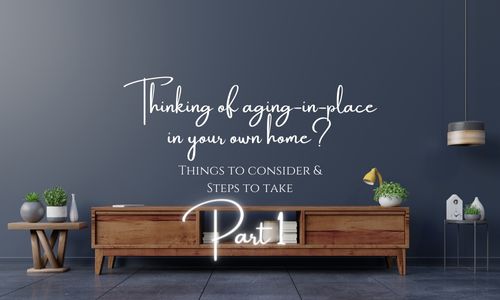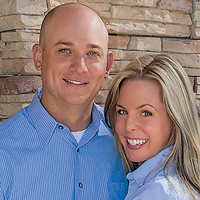Part I
Should I stay in my home as I age?
Well, aging and how it may change our lives is not the most fun subject to discuss—but one that should not be ignored. If you are lucky enough to live to an advanced age, your lifestyle needs will probably change. Fifty years ago, options were limited. Most people moved back in or at least near their grown children, or went into communal resident facilities. Today, things are vastly different. There are a growing number of people who do not have children—or sadly, are estranged from them. People are living longer and generally have better health and mobility than in past decades. Although there are some truly incredible retirement and assisted living facilities in Oro Valley and the Greater Tucson area (such as continuing care retirement community Splendido in Oro Valley or the upcoming La Posada, also in Oro Valley), a new poll revealed that 88% of people aged 50-80 prefer to stay at home. The part of the poll that caught my eye was that half of them said they had “given little or no thought to the steps they’d need to take so they could remain safely and comfortably at home in their old age”. There are pros and cons to staying in your home as you age and “retirement homes” —but if you are considering aging-in-place at home there are all sorts of technological and home improvement products that allow most people to age gracefully in their own homes. (We will get to that in Part 2 of this feature!)
Pros and cons to aging-in-place
On the benefit side to aging-in-place, staying in your own home provides a sense of familiarity. If you have lived in your home for several years, leaving may cause emotional stress. Cost is another factor. Independent living at a facility will cost at least a few thousand a month in our area (as of 2022), and this may only cover the very basics such as room/apartment, utilities, community amenities and maintenance. Meals, transportation, housekeeping, etc. are usually add-ons, and can become very expensive. Many communities/facilities in the area offer an array of living options, from private rooms or apartments to posh modern villas. Just remember, the more expansive the living quarters, the larger the bill. Most facilities expect you to be able to provide extensive financial and health information before being accepted. If you have furry little ones, be aware that some communities will allow pets while others will not.
Another consideration that was highlighted during the early days of the pandemic—seniors living in close quarters are more susceptible to communicable disease.
On the flip side—most will be left up to you if you decide to stay at home. Thankfully, in an age of Door Dash, Amazon and Instacart (as well as unlimited other internet-based choices), you are able have groceries, pharmacy items and meals easily delivered. Uber, Lyft and other transportation services are readily available to take you wherever you need to go. (I remember when we first moved to Oro Valley in the pre-Uber days you could not get a taxi to come out “all this way”. Boy, have times changed!) You will need to coordinate any cleaning or landscaping help you may need, and when something breaks you can’t simply call the concierge and have them send the maintenance person over.
But the potential to be isolated if you need someone in an emergency is probably one of the largest drawbacks to staying at home. This issue too, however, has seen the tech industry develop some amazing ways to keep you in touch and safe at home.
Many independent living communities have programs where you can transition into assisted-living or skilled-care nursing if you need it. These are known as Continuing Care Retirement Communities (CCRCs). A benefit of a community like this is that you only really move once. (*However, be advised that some of these communities will only accept you before you need assisted living help, expecting you to eventually transition to more in-depth care. If you wait until you require a great level of assistance your options to enter some facilities may be limited.) If you opt to stay at home, plan to have a contingency plan in case something occurs that would require extra care. This could be relocating to a facility or having home care. A huge benefit of being in a community/facility is that there is generally always someone available. If someone calls in sick, there will be another person to cover for them. If you are at home, make sure whatever person or service you engage to help you has enough employees to make sure you will be looked after if someone is a no-show for whatever reason.
Should I stay in my current home or buy a new one to age-in-place?
Location, location, location.
There are several things to consider when making this decision. Funnily enough, one of them is just like the old real estate credo—location, location, location. The geographical location should offer what you need in the way of amenities, social interaction, medical care only moments away. Don’t assume you will feel as comfortable driving long distances or at night when you are older. Convenience will probably become more of a priority as time goes by. Do you have adult children in the area? If you will be depending on them for frequent assistance, living five or ten minutes away rather than 30-40 minutes can make a huge difference.
Consider basic functionality—and be realistic.
Stairs become more and more of an issue as we age. Even when you are extremely healthy and able to climb stairs several times a day, things can happen. My grandmother-in-law is in her 90’s and unbelievably healthy—but she took a spill one day and her knee was out of commission for months. She still lives in the two-story she has been in for decades, and it does not have a full bath and bedroom on the main level Therefore, she had a stairlift installed—but this is not always possible. My father-in law has a home with multiple levels back in Canada—ranging from 2-10 steps—and no full bedroom and bath on the main level. There is no way to change it—and it would require multiple stairlifts. Whenever we show homes that do not have a bedroom and full bath on the main level, we always educate our clients on the drawbacks and potential resale objections.
What if your property is too large for your future needs? Our current home is on an acre of property and the home is very large. Although Jay maintains that he never wants to move again, the thought of trying to maintain it in our 70’s or 80’s is daunting. I want to be spending my time doing the things I enjoy at that age—and while I hope to be very healthy and capable, I have noticed a difference in energy levels from a couple of decades ago! A smaller home and outdoor space would be much more feasible for us later on—I hope in our same neighborhood. If your home is a lot to take care of, you may want to strongly consider making a change before it becomes overwhelming.
In Closing
If you have a home that checks the location box and where the functionality can be changed in a cost-effective and functionally acceptable manner, yay! If not, it may be best to sell your current home and purchase one that does fit the criteria. Luckily, in Oro Valley and the Greater Tucson area, there are so many options! There are huge complete communities such as SaddleBrooke and Sun City Vistoso tailored to active adult lifestyles and offering homes that were built to suit older adults.
An age-restricted community not your thing? In Arizona, one-story homes are very common and almost all neighborhoods have some, if not many. Whether you are staying in your current home or purchasing a new one, you may still need to make some adjustments. Part 2 of this feature is devoted to the steps you can take to get your current home ready for aging-in-place, and some pretty cool products and services that you might find useful. In addition, we will talk about what to look for if you decide to sell and buy a new property.
We are Oro Valley real estate agents also serving the surrounding areas of North Tucson, SaddleBrooke and Marana. Contact us anytime—we are ready to assist with all your real estate needs!


